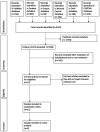Effect of media distraction (audio-visual and music) for pain and anxiety control in patients undergoing shock-wave lithotripsy: A systematic review and meta-analysis
- PMID: 33936280
- PMCID: PMC8082642
- DOI: 10.3892/etm.2021.10055
Effect of media distraction (audio-visual and music) for pain and anxiety control in patients undergoing shock-wave lithotripsy: A systematic review and meta-analysis
Abstract
Audio-visual (AV) or music distraction may be used to reduce pain during several healthcare procedures. The present manuscript is a systematic review and meta-analysis to assess the effectiveness of media distraction in reducing pain and anxiety in extracorporeal shock wave lithotripsy (ESWL) patients. The PubMed, Embase, Scopus, BioMed Central, Ovoid and CENTRAL (Cochrane Central Register of Controlled Trials) databases were screened for studies assessing the role of media distraction (music/AV media) in reducing pain and anxiety of ESWL patients. Data were summarized using the mean difference (MD) with 95% confidence intervals (CI). A total of 11 randomized controlled trials were included. Pooled analysis indicated a statistically significant difference in pain outcomes with media distraction [mean difference (MD): -1.18; 95% CI: -2.35, -0.01; I2=96.8%)]. Subgroup analysis indicated that both AV media (MD: -2.94; 95% CI: -4.70, -1.17; I2=79.2%) and music (MD: -0.86; 95% CI: -1.37, -0.35; I2=62.5%), led to significant reduction in pain outcomes. Pooled analysis indicated a statistically significant reduction of anxiety scores with the use of media distraction (MD: -3.91; 95% CI: -6.44, -1.38; I2=77.7%). To conclude, the present review suggests that media distraction in the form of AV media or music may be beneficial in reducing the pain and anxiety of patients undergoing ESWL. Evidence is, however, weak considering the small effect size, confidence intervals being close to zero, and instability of the results on sensitivity analysis. In clinical practice, media distraction may be used during ESWL as a nursing intervention, but a clinically important reduction of pain and anxiety may not be expected.
Keywords: analgesia; audiovisual; complementary therapy; distraction; music; renal stones; urology.
Copyright: © Hu et al.
Conflict of interest statement
The authors declare that they have no competing interests.
Figures






Similar articles
-
Watching a movie or listening to music is effective in managing perioperative anxiety and pain: a randomised controlled trial.Knee Surg Sports Traumatol Arthrosc. 2023 Dec;31(12):6069-6079. doi: 10.1007/s00167-023-07629-z. Epub 2023 Oct 28. Knee Surg Sports Traumatol Arthrosc. 2023. PMID: 37897624 Free PMC article. Clinical Trial.
-
Impact of music on anxiety and pain control during extracorporeal shockwave lithotripsy: A protocol for systematic review and meta-analysis.Medicine (Baltimore). 2021 Jan 29;100(4):e23684. doi: 10.1097/MD.0000000000023684. Medicine (Baltimore). 2021. PMID: 33530169 Free PMC article.
-
Effectiveness of Audio and Audio-Visual Distraction Aids for Management of Pain and Anxiety in Children and Adults Undergoing Dental Treatment- A Systematic Review And Meta-Analysis.J Clin Pediatr Dent. 2022 Mar 1;46(2):86-106. doi: 10.17796/1053-4625-46.2.2. J Clin Pediatr Dent. 2022. PMID: 35533223
-
Comparison of Two Different Distraction Methods Affecting the Level of Pain and Anxiety during Extracorporeal Shock Wave Lithotripsy: A Randomized Controlled Trial.Pain Manag Nurs. 2018 Jun;19(3):295-302. doi: 10.1016/j.pmn.2017.09.005. Epub 2017 Dec 14. Pain Manag Nurs. 2018. PMID: 29248604 Clinical Trial.
-
Sounds of comfort: the impact of music therapy on labor pain and anxiety in primigravida women during vaginal delivery: a systematic review and meta-analysis.Reprod Health. 2025 May 9;22(1):67. doi: 10.1186/s12978-025-02023-z. Reprod Health. 2025. PMID: 40346658 Free PMC article. Review.
Cited by
-
Watching a movie or listening to music is effective in managing perioperative anxiety and pain: a randomised controlled trial.Knee Surg Sports Traumatol Arthrosc. 2023 Dec;31(12):6069-6079. doi: 10.1007/s00167-023-07629-z. Epub 2023 Oct 28. Knee Surg Sports Traumatol Arthrosc. 2023. PMID: 37897624 Free PMC article. Clinical Trial.
-
Management of preoperative anxiety with non-pharmacological methods in pediatric patients in resource-limited settings: a literature review.Ann Med Surg (Lond). 2025 Jan 31;87(2):780-790. doi: 10.1097/MS9.0000000000002912. eCollection 2025 Feb. Ann Med Surg (Lond). 2025. PMID: 40110318 Free PMC article. Review.
-
Comparing Auditory and Visual Distractions for Reducing Pain Severity and Pain Anxiety in Older Outpatients with Burn: A Randomized Controlled Trial.Geriatrics (Basel). 2022 Apr 30;7(3):54. doi: 10.3390/geriatrics7030054. Geriatrics (Basel). 2022. PMID: 35645277 Free PMC article.
-
Does addition of aromatherapy and music help to reduce pain and anxiety during shockwave lithotripsy compared to standard analgesia alone? A randomised controlled trial.Int Urol Nephrol. 2023 Oct;55(10):2405-2410. doi: 10.1007/s11255-023-03684-0. Epub 2023 Jul 3. Int Urol Nephrol. 2023. PMID: 37395910 Clinical Trial.
-
The Effect of Audio and Audiovisual Distraction on Pain and Anxiety in Patients Receiving Outpatient Perineal Prostate Biopsies: A Prospective Randomized Controlled Study.Cancers (Basel). 2025 Mar 12;17(6):959. doi: 10.3390/cancers17060959. Cancers (Basel). 2025. PMID: 40149294 Free PMC article.
References
LinkOut - more resources
Full Text Sources
Other Literature Sources
